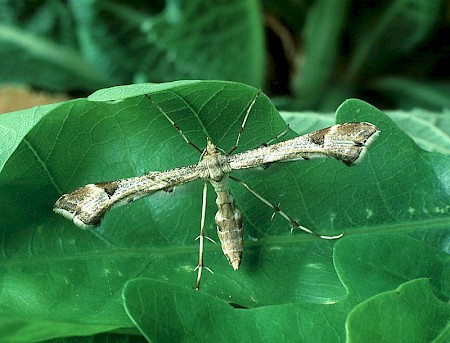45.004 BF1501
Triangle Plume Platyptilia gonodactyla
([Denis & Schiffermüller], 1775)
Wingspan 20-30 mm.
This relatively common member of the 'Plume' moths has a widespread distribution in Britain, and is fairly common in open, grassy habitats and waste ground.
The larvae feed in the stems and flowers of coltsfoot (Tussilago).
The adults fly in two generations; one in May and June, and a second in the autumn. They are regularly attracted to light.
- More details (Description Ian. F. Smith):
Larva:
Foodplant: Tussilago farfara. September-May, in leaf mine (Autumn), flower stem/rootstock (to late March), buds, flowers, seeds (Spring). Spun seeds retained on drooping head. July-August in leaf mine and then external on leaf.
Length: 6 mm (late March) Head: Shiny black. Mouthparts pitchy black.
Prothoracic shield: Black. Divided in posterior half by very fine light medial line.
Thoracic legs: Black.
Body: Yellow. Broad reddish dorsal, lateral and spiracular lines.
Spiracles: Pitchy brown peritreme.
Pinacula: Small, grey. Subspiracular and thoracic pinacula larger. On A8 two transverse grey-black lines link the pairs of dorsal pinacula. On A9 the dorsal and dorsolateral pinacula are linked by a single grey-black transverse line.
Setae: Blackish translucent.
Anal plate: Grey-black with black spots.
Prolegs: Concolorous with venter. Planta transparent colourless. Anal prolegs with lateral grey-black sclerite. Crochets black.

 UKMoths
UKMoths 







